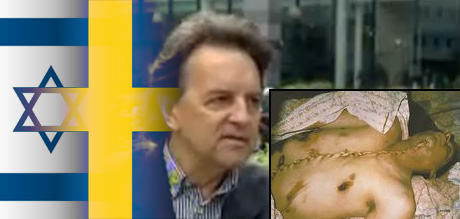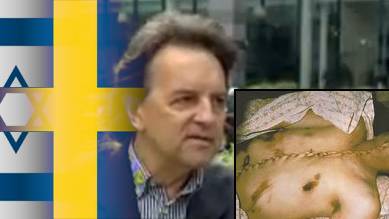The article that rocked Israel and Sweden
Source: cannonfire.blogspot.com

Swedish journalist Donald Bostrom caused an international incident with the publication of this article on allegations that Israel illegally harvested organs from Palestinians in the early 1990s. The Israeli reaction was predictably furious and indignant:
"The article was a shocking piece of blatant racism," Israeli Foreign Ministry spokesman Yigal Palmor told CNN on Wednesday.The Huffington Post, which did not bother to deal with the substance of the piece, also dismissed Bostrom's article as an anti-Semitic fabrication:
"This kind of medieval blood libel cannot be tolerated in any society and the Swedish public and government have to condemn and reject this appalling [incitation] before it actually encourages someone to commit hate crimes."
Israel -- through its ambassador in Stockholm, Sweden -- is asking Sweden's government to condemn the article, Palmor said.
In Sweden, the article drew a critical editorial from a rival daily, Sydsvenskan, which said it followed the "usual template of a conspiracy theory."That, in my view, is a rather condescending attitude.
Israel's ambassador to Sweden, Benny Dagan, said the piece did not indicate a climate of general hostility toward Israel.
"It's certain elements," he told Israel Radio. "It's not all Sweden or mainstream Sweden or the Swedish parliament."
Bostrom's article was, in fact, based on an event he personally witnessed, and on eyewitness testimony he gathered while on assignment in the occupied territories in 1992. He also drew heavily from a piece published in the Jerusalem Post, which nobody ever mistook for Der Stürmer. His observations coincide with material gathered by respected author David Yallop, who was also covering the West Bank at that time. An earlier Cannonfire post quoted and discussed Yallop's investigation.
I urge readers not to form an impression of Bostrom's piece based on misleading reports. Judge the original for yourself. If you do, you will probably agree with my view that Bostrom writes to a high journalistic standard -- higher, certainly, than is the case with much of what passes for "news" in this country.
To call his piece "anti-Semitic" is to stretch the meaning of that term beyond the limits of elasticity. Bostrom's article also accuses China of harvesting organs from prisoners. As a little Googling will reveal, any number of writers have made the same claim -- yet no-one ever accuses those writers of harboring racist attitudes toward the Chinese.
I've taken the liberty of preparing a translation of the article. I do not know Swedish (aside from a few words picked up during my Ingmar Bergman phase), and thus had to rely on a comparison of three machine translations, along with some rather laborious word-for-word translation. I believe that this version accurately conveys the meaning of each sentence in idiomatic English. However, it is not a professional translation, and on a few occasions I had to guess at the author's intent. Those guesses were based on context and common sense. (I must confess to being unsure about the Swedish word here translated as "incisions.")
If you are fluent in Swedish, I urge you to offer suggestions for improvement. I will re-write and re-publish accordingly.
The translation appears below the asterisks.
* * *
Palestinians accuse the Israeli army of stealing body parts from its victims.
Donald Boström describes the international transplant scandal -- and how he himself became a witness to an assault on a 19-year-old boy.
“I am what you might call a ‘matchmaker,’" said Levy Izhak Rosenbaum of Brooklyn, USA, in a secret recording with an FBI agent he thought was a customer. Ten days later, at the end of July of this year, Rosenbaum was arrested in connection with a large tangle of corruption uncovered in New Jersey: Rabbis and trusted elected officials had for years engaged in money laundering and the illegal organ trade, and now the network was being rolled up like the mob on The Sopranos. Rosenbaum’s matchmaking was not about romance but about buying and selling kidneys from Israel on the black market. According to his own statement, he would buy body parts from the needy people in Israel for $10,000 and sell them to desperate patients in the U.S. for $160,000. The waiting time for a legal kidney transplant is an average of nine years.
The accusations have shaken the American transplant industry. If this is true, it is the first time organ trafficking has been documented in the U.S., say experts quoted in the [online] magazine New Jersey Real-Time News.
Asked how many organs he has sold, Rosenbaum responded: Quite a lot. Many. And I have never failed, he brags. His business has been going on for a very long time.
Francis Delmonici, Harvard Professor of Transplantation Surgery, and a board member of the National Kidney Foundation's Board of Directors, told the same publication that similar organ trafficking also occurs in Israel and elsewhere in the world. Roughly ten percent of the world’s 63,000 kidney transplantations are done illegally, says Delmonici.
Hot countries for this illegal activity include Pakistan, the Philippines and China, where it is believed that organs are taken from executed prisoners. But Palestinians also strongly suspect that their captured young men have undergone involuntary organ harvesting, just as occurs in Pakistan and China. This very serious allegation has many asking whether the ICJ (the International Court of Justice) should open an investigation into possible Israeli war crimes.
Israelis has recurrently ended up in hot water for its unethical way of dealing with organs and transplantation. Some countries, including France, cut off organ cooperation with Israel back in the 1990s, and the Jerusalem Post writes that "other countries in Europe are expected to follow France's example soon."
Half of the new kidneys implanted by Israelis since the early 2000's have been purchased illegally from Turkey, Eastern Europe or Latin America. Israeli health authorities have full knowledge of the business, but do nothing to stop it. A 2003 conference revealed that Israel is the only Western country whose medical profession does not condemn the illegal organ trade or take any legal action against the doctors involved in this criminal process. On the contrary, the chief doctors at major hospitals are involved in most illegal transplantations, according to Dagens Nyheter (December 5, 2003).
In the summer of 1992, in an attempt to overcome an organ shortage in the country, Ehud Olmert – then Israel’s minister of health -- instituted a major campaign to induce the Israeli population to become organ donors. Half a million pamphlets were distributed in local newspapers, inviting citizens to register to donate their organs after their death. Ehud Olmert was the first to sign up.
According to the Jerusalem Post, the campaign proved successful within a couple of weeks. No less than 35,000 people had registered; the usual number was 500 a month. But, as journalist Judy Siegel went on to note, the gap between supply and demand remained high. Five hundred people needed kidney transplants, but only 124 could undergo surgery. Of the 45 persons in need of a new liver, only three had the opportunity to undergo surgery in Israel.
During this organ donation campaign, young Palestinian men disappeared, only to be returned to their villages five days later, dead and bearing large sewn incisions.
Word of the incisions terrified the population in the West Bank and Gaza. There was talk of a dramatic increase in young men who would vanish, their autopsied bodies later receiving nocturnal funerals.
I was in the area, working on a book. On several occasions, I was contacted by UN staffers who were concerned about these developments. Those who contacted me believed that organ theft actually took place, but felt unable to act. On behalf of a television company, I then went around and spoke to a large number of Palestinian families in the West Bank and Gaza, who indicated that the bodies of their sons had been desecrated when they were killed. One of the examples I saw during this eerie trip was that of a young stone-thrower named Bilal Achmed Ghanan.
The clock was approaching midnight when engine sounds from Israeli forces were heard on the outskirts of the northern West Bank village of Imatin. The village's two thousand inhabitants awakened and stood as silent shadows. Some were on rooftops, others were behind their curtains, houses or trees, which gave protection in the dark during curfew but still offered a clear view of what would become a graveyard for the village's first martyr. The military had cut off all electricity around the village and the area was under military control – not even a cat could move outdoors without risking its life. The darkness and the deafening silence were broken only by a quiet sob, and I cannot remember if it was the cold or excitement that made us shiver.
Five days earlier, May 13, 1992, Israeli special forces had set up a carpenter’s shop for an ambush. The person that the special forces had been instructed to kill was 19-year-old Bilal Achmed Ghanan, one of those young Palestinians whose stone-throwing activities had made life difficult for the Israeli occupying power.
Bilal Ghanan had been one of the leading stone-throwers for a couple of years. This meant that he, along with other wanted stone-throwers, lived outdoors in the hills above Nablus. To be captured meant death, and all the stories about torture did not improve matters. Thus they remained in the mountains. But for some reason, on one unfortunate day in mid-May, Bilal came down and wandered unchecked through the village, passing the carpenter’s house. Why he came down that day was a question that not even his older brother Talal could answer. Perhaps he needed food and supplies.
Everything went according to plan for the Israeli special forces. They put out their cigarettes and set down their cans of Coca-Cola cans as they calmly aimed through the broken window. When Bilal was sufficiently close, they pulled their triggers. The first shot hit in the chest. According to villagers who witnessed the incident, he was then shot in each leg. Then two soldiers ran out of the carpenter’s shop and shot him once again in the stomach. Finally, they took Bilal by the feet and dragged him up the 20 steps of the stone staircase leading to the carpenter’s shop.
Villagers said that nearby people from both the UN and Red Crescent had heard the shots and had gone to the spot to take care of the injured. An argument about who would take care of the victim ended when the Israeli forces loaded the severely injured Bilal into a jeep and drove off to the village's outskirts. A military helicopter was seen carrying Bilal to an unknown destination.
Five days later he came back in the dark, dead and wrapped in green hospital fabrics. When a military column came down from the Bilal Abu Kabir autopsy center outside Tel Aviv and stopped at Bilal Ghanan’s final resting place, someone recognized Israeli Group Captain Yahya. "The most difficult of them all," this person whispered into my ear. When Captain Yahya’s men unloaded the body and exchanged the green fabric for a light cotton fabric, a few male relatives were chosen to perform the job of digging soil and mixing cement.
Along with the sharp sounds of shovels, we heard occasional laughter from the soldiers who were trading jokes with each other. When Bilal was laid out in his grave, his chest was uncovered -- and suddenly the abuse that he had undergone became clear to the handful of onlookers. Bilal was far from the first corpse with an incision from the abdomen to the chin. Speculation about the reason for this incision began to spread.
The affected Palestinian families in the West Bank and Gaza were sure about what had happened to their sons. Our sons are used as forced organ donors, I was told by relatives of Khaled from Nablus, and by the mother of Raed from Jenin, and by the uncles of Machmod and Nafes from Gaza. All of these young men had gone missing for a number of days only to be returned at night, killed and dissected.
Nafes’ outraged uncle had many questions: “Why do they keep the bodies up to five days before we can bury them? What happens to the bodies in the meantime? And why do an autopsy against our will, when the cause of death is obvious? And why bring the bodies back at night? And why the military escort? And why are burial areas closed off? And why do they cut off the electricity?”
The families of the killed Palestinian men are no longer in doubt.
A spokesman for the Israeli army said that allegations of organ theft were Palestinian fabrications. All killed Palestinians are routinely subject to autopsy, he said.
Bilal Achmed Ghanan was one of 133 Palestinians killed by various means that year. According to Palestinian statistics, those deaths occurred in a number of ways: shot in the street, explosions, beatings, tear gas, deliberately hit, hung in the jail, shot in the school, killed at home, etc. Of the 133 persons killed, aged four months to 88 years old, 69 had autopsies – i.e., only half of the dead. The army spokesman’s claim that killed Palestinians are routinely autopsied does not hold true in the Occupied Territories. Questions remain.
We know that the need for organs in Israel is large, that an extensive trade in illegal organ transplantation is ongoing, and that this trade has existed for a long time. We know that it occurs with the blessing of the authorities and the senior doctors at the major hospitals involved. And we know that when Palestinian young men disappeared, they were returned five days later -- in secrecy, at night – their bodies cut open and sewn back together.
The time has come to shed light on this macabre activity. We must learn what is going on and what has occurred in the Israeli occupied territories since the intifada started.
Donald Boström
Source: cannonfire.blogspot.com






















